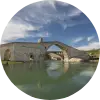
















Zerzevan Fortress, located within the boundaries of Demirölçek neighborhood in the Çınar district, between Diyarbakır and Mardin, is a historic structure and military settlement area. Used as a border garrison during the Roman Empire period, this fortress is considered one of the most important Eastern Roman monuments in Diyarbakır and was included in the UNESCO World Heritage Temporary List in 2020.
History and Background:
While the exact period of its initial construction is uncertain, it is believed that there was a fortress named "Kinabu" during the Assyrian period, which was possibly utilized during the Persian period as well. The existing architectural remains and excavation findings suggest that the site was utilized in the 3rd century AD and retained its strategic importance until the arrival of Islamic armies in 639 AD. The Roman-era walls and structures were likely repaired during the reigns of Emperor Anastasius I and Emperor Justinian I, with some possibly reconstructed.
Architecture and Structures:
The fortress is surrounded by walls ranging from 12 to 15 meters in height and 2.1 to 3.2 meters in thickness, with 10 towers and 2 towers along the 1.2-kilometer-long wall. A three-story large tower is located to the south of the settlement, standing at a height of 19.2 meters. Its original height may have reached up to 21 meters. Military structures for defense purposes are found to the south of the settlement, while traces of public buildings, streets, and residences are observed to the north. Structures such as water channels, offering dishes, stone quarries, and necropolises are located outside the walls.
Excavation and Restoration:
Excavations started in the fortress in 2014, revealing remains including a 12-meter-high, 1200-meter-long wall, observation towers, a church, a palace, residences, rock tombs, baths, grain and weapon depots, and 54 cisterns. The Mitras Temple, discovered in 2017, is currently the most prominent structure within the fortress.
Zerzevan Fortress not only represents a military settlement but also bears traces of civilian life, representing significant archaeological richness. Its inclusion in the UNESCO World Heritage Temporary List in 2020 supports its potential to become a major tourist and cultural attraction both nationally and internationally.